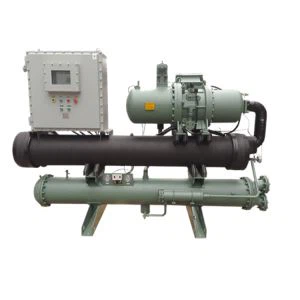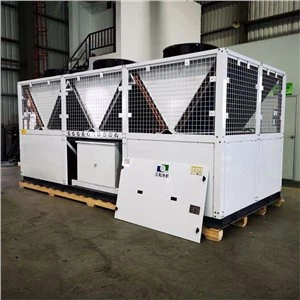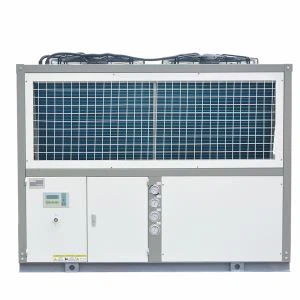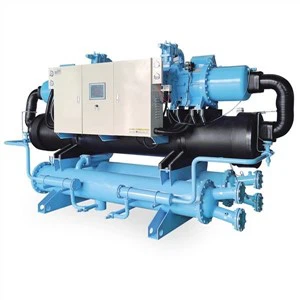As a supplier of air-cooled scroll chillers, I've witnessed firsthand the widespread adoption of these systems in various industries. Air-cooled scroll chillers are popular due to their compact design, relatively easy installation, and efficient cooling capabilities. However, like any technology, they come with their fair share of disadvantages. In this blog post, I'll delve into the drawbacks of air-cooled scroll chillers to provide a comprehensive understanding for potential buyers and industry professionals.
Higher Energy Consumption
One of the most significant disadvantages of air-cooled scroll chillers is their relatively high energy consumption compared to water-cooled chillers. Air-cooled chillers rely on ambient air to dissipate heat from the refrigerant. Since air has a lower heat transfer coefficient than water, these chillers require more energy to achieve the same cooling effect.
In regions with high ambient temperatures, the energy consumption of air-cooled scroll chillers can increase substantially. As the outside air temperature rises, the chiller has to work harder to reject heat, leading to higher power consumption. This not only results in increased operating costs but also has a negative impact on the environment due to the higher carbon footprint associated with increased energy use. For industries that operate their chillers continuously, such as data centers or manufacturing plants, the cumulative energy costs can be a significant financial burden over time.
Limited Cooling Capacity
Air-cooled scroll chillers typically have a limited cooling capacity compared to larger water-cooled chillers. The cooling capacity of an air-cooled scroll chiller is constrained by the size of the condenser and the ability of the ambient air to absorb heat. As a result, these chillers are generally more suitable for small to medium-sized applications.
In large industrial settings or facilities with high cooling demands, multiple air-cooled scroll chillers may need to be installed in parallel to achieve the required cooling capacity. This not only increases the initial investment cost but also requires more space for installation and maintenance. Additionally, operating multiple chillers simultaneously can lead to increased energy consumption and complexity in system management.
Noise Pollution
Another drawback of air-cooled scroll chillers is the noise they generate during operation. The fans and compressors in these chillers produce a significant amount of noise, which can be a nuisance in both industrial and commercial settings. In office buildings, hospitals, or residential areas, the noise from air-cooled chillers can disrupt the normal activities and cause discomfort to occupants.
To mitigate the noise issue, additional soundproofing measures may need to be implemented, such as installing acoustic enclosures or locating the chillers in a separate, well-insulated room. However, these solutions can add to the overall cost of the chiller system and may not completely eliminate the noise problem.
Dependence on Ambient Conditions
Air-cooled scroll chillers are highly dependent on ambient air conditions for their performance. The efficiency and cooling capacity of these chillers can be significantly affected by factors such as temperature, humidity, and air quality.


In hot and humid climates, the performance of air-cooled scroll chillers can degrade rapidly. High humidity levels can reduce the effectiveness of the condenser in dissipating heat, leading to increased refrigerant temperatures and reduced cooling capacity. Additionally, dust, dirt, and other airborne particles in the ambient air can accumulate on the condenser coils, reducing the heat transfer efficiency and increasing the risk of mechanical failures.
Regular maintenance, including cleaning the condenser coils and filters, is essential to ensure the optimal performance of air-cooled scroll chillers. However, this can be time-consuming and costly, especially in environments with poor air quality.
Higher Maintenance Requirements
Compared to water-cooled chillers, air-cooled scroll chillers generally have higher maintenance requirements. The fans, compressors, and condenser coils in these chillers are exposed to the ambient air, which can cause wear and tear over time. The condenser coils are particularly susceptible to damage from dirt, debris, and corrosion, which can reduce their heat transfer efficiency and lead to system failures.
In addition to regular cleaning and inspection, air-cooled scroll chillers may require more frequent replacement of components such as filters, belts, and bearings. The cost of maintenance and replacement parts can add up over the lifespan of the chiller, making it a more expensive option in the long run.
Environmental Concerns
Air-cooled scroll chillers use refrigerants that can have a significant impact on the environment. Many of the commonly used refrigerants, such as R-410A, have a high global warming potential (GWP). When these refrigerants leak into the atmosphere, they contribute to climate change by trapping heat and increasing the Earth's temperature.
In recent years, there has been a growing trend towards using more environmentally friendly refrigerants with lower GWP. However, the transition to these new refrigerants can be costly and may require modifications to the existing chiller system. Additionally, the proper handling and disposal of refrigerants are crucial to minimize their environmental impact, which adds another layer of complexity to the operation and maintenance of air-cooled scroll chillers.
Conclusion
While air-cooled scroll chillers offer several advantages, such as compact design and easy installation, they also come with a number of disadvantages. Higher energy consumption, limited cooling capacity, noise pollution, dependence on ambient conditions, higher maintenance requirements, and environmental concerns are all factors that need to be considered when choosing a chiller system.
Despite these drawbacks, air-cooled scroll chillers can still be a suitable option for many applications, especially in small to medium-sized facilities with moderate cooling demands. At our company, we offer a range of Air Cooled Scroll Compressor Chiller that are designed to meet the specific needs of our customers. Our Industrial Air Cooled Scroll Chillers are built with high-quality components and advanced technology to ensure reliable performance and energy efficiency. We also provide Chiller for Vacuum Coating that are specifically designed for the unique requirements of the vacuum coating industry.
If you're considering purchasing an air-cooled scroll chiller for your facility, we encourage you to contact us to discuss your specific needs and requirements. Our team of experts can provide you with detailed information and guidance to help you make an informed decision. We look forward to working with you to find the best chiller solution for your business.
References
- ASHRAE Handbook - Refrigeration. American Society of Heating, Refrigerating and Air-Conditioning Engineers.
- "Performance Analysis of Air-Cooled Scroll Chillers in Different Climatic Conditions." Journal of Refrigeration Engineering.
- "Environmental Impact of Refrigerants in Chiller Systems." International Journal of Environmental Science and Technology.






